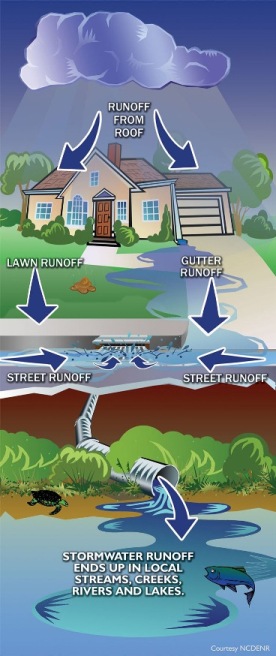General Stormwater Questions
What is stormwater runoff?
Stormwater runoff is rainwater or snowmelt that does not soak into the ground - but runs off land surfaces such as lawns, roofs, parking lots and roads.
Why can stormwater runoff be a problem?
Stormwater runoff can cause two types of problems: it can be a source of water pollution and it can also cause flooding.
How does stormwater runoff become polluted?
Like rainwater, stormwater starts out as clean water. As storm water runs over the land surface, it can pick up anything on the ground surface, such as oils, greases, fertilizers, pesticides, lawn debris, soil, and litter and carry these pollutants untreated into the nearest roadway ditch, storm drain inlet or water body. People going about their daily activities are the number one source of stormwater pollution. Many of us are not aware of how we impact water quality. Some common examples include over fertilizing our lawns, using more pesticide than necessary, not picking up pet waste, using too much salt or de-icer to de-ice driveways, not fixing oil leaks in our vehicles, and littering.
How can stormwater runoff contribute to flooding?
Stormwater runoff can also contribute to flooding. Impervious surfaces like driveways, sidewalks, and streets prevent stormwater runoff from naturally soaking into the ground. As more and more areas become developed, more land surface becomes impervious as it is compacted or covered with streets, driveways, rooftops, parking lots etc. Increased impervious cover decreases the amount of rainfall that can naturally infiltrate into the soil and increases the volume and rate of storm water runoff. These changes lead to more frequent and severe flooding of waterways.
Where does stormwater go?
Stormwater runs off the land and either flows directly into nearby streams or travels there through drainage systems, such as curbs and gutters, inlets, storm sewers, ditches, detention ponds and channels. Anything that enters the stormwater system is discharged untreated into the lakes, streams, rivers or wetlands that we use for swimming, fishing and providing drinking water.
